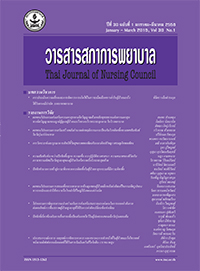การวิเคราะห์และบูรณาการดัชนีชี้วัดสุขภาพพอเพียงกับแนวคิด ปรัชญาเศรษฐกิจพอเพียง
Keywords:
แนวคิดปรัชญาเศรษฐกิจพอเพียง, ดัชนีชี้วัดสุขภาพพอเพียงsufficient-health indices, philosophy of sufficiency economyAbstract
บทคัดย่อ: วัตถุประสงค์ของการวิจัย: เพื่อวิเคราะห์และบูรณาการดัชนีชี้วัดสุขภาพพอเพียง กับแนวคิดปรัชญาเศรษฐกิจพอเพียง
การออกแบบการวิจัย: การวิจัยเชิงคุณภาพโดยศึกษาจากข้อมูลทุติยภูมิที่ได้มาจากการพัฒนาดัชนีชี้วัดสุขภาพพอเพียงระดับบุคคล ครอบครัวและชุมชนภายใต้แนวคิดปรัชญาเศรษฐกิจพอเพียง
การดำเนินการวิจัย: รวบรวมข้อมูลทุติยภูมิที่เป็นข้อมูลดัชนีชี้วัดสุขภาพพอเพียงจำนวน 36 ตัวชี้วัด (ประกอบด้วยระดับบุคคลมี 8 ตัวชี้วัด ระดับครอบครัวมี 12 ตัวชี้วัด และระดับชุมชนมี 16 ตัวชี้วัด) เครื่องมือวิจัยเป็นแบบตรวจสอบลักษณะตามแนวคิดปรัชญาเศรษฐกิจพอเพียง วิเคราะห์ข้อมูลทุติยภูมิโดยวิธีการวิเคราะห์ข้อมูลเชิงเนื้อหา
ผลการวิจัย: เมื่อบูรณาการดัชนีชี้วัดสุขภาพพอเพียงที่จำแนกตามระดับบุคคล ครอบครัวและชุมชน ให้เข้ากับลักษณะตามปรัชญาเศรษฐกิจพอเพียงทั้ง 5 ด้าน พบว่า 5 ตัวชี้วัด เข้าได้กับด้านความพอประมาณ 7 ตัวชี้วัดเข้าได้กับด้านความมีเหตุผล 11 ตัวชี้วัดเข้าได้กับด้านการมีภูมิคุ้มกัน 9 ตัวชี้วัดเข้าได้กับด้านการมีความรู้ และ 4 ตัวชี้วัดเข้าได้กับด้านการมีคุณธรรม
ข้อเสนอแนะ: จากการศึกษาครั้งนี้ทำให้เกิดความเข้าใจดัชนีชี้วัดสุขภาพพอเพียงเมื่อเชื่อมโยงตามปรัชญาเศรษฐกิจพอเพียงได้อย่างเป็นรูปธรรม และสามารถนำมาใช้ในประเมินสุขภาพพอเพียงที่บ่งชี้ถึงการบูรณาการดูแลสุขภาพตามแนวคิดปรัชญาเศรษฐกิจพอเพียง ซึ่งจะเป็นข้อมูลพื้นฐานให้พยาบาลนำไปใช้ในการวางแผนการดูแลประชาชนให้มีสุขภาพพอเพียง และเกิดสุขภาพดีต่อไป
Abstract: Objective: To analyse the integration of sufficient-health indices with the philosophy of sufficiency economy.
Design: Qualitative research based on secondary data obtained from the development of individual-, family- and community-level sufficient-health indices applied in accord with the philosophy of sufficiency economy.
Implementation: Secondary data were first collected, a set of 36 sufficient-health indices (8 individual-level, 12 family-level and 16 community-level indices). The instrument was a feature checklist based on the philosophy of sufficiency economy. The method of content analysis was applied to the secondary data.
Results: Integration of the sufficient-health indices, which were divided into individual, family and community levels, with 5 relevant principles of the philosophy of sufficiency economy, showed that 5 of the indices conformed to the principle of moderation, 7 to the principle of sensibility, 11 to the principle of immunity, 9 to the principle of knowledgeability and 4 to the principle of integrity.
Recommendations: This study has led to a more concrete understanding of the relationship between sufficient-health indices and the philosophy of sufficiency economy. Such an understanding could be applied to healthcare practice and planning, for the purpose of maintaining long-term healthiness amongst the general public.








